Economic Policies: Long-Term Strategies for Economic Growth in the UK
VerifiedAdded on 2020/01/07
|10
|3397
|203
Report
AI Summary
This report provides a comprehensive analysis of economic policies, particularly focusing on how governments, specifically the UK government, can utilize long-term strategies to facilitate economic growth. It delves into the intricacies of fiscal policy, including taxation and government spending, and how these can be manipulated to influence aggregate demand and stimulate economic activity. The report also examines monetary policy, detailing how central banks control interest rates and manage the money supply to achieve economic stability, manage inflation, and encourage investment. Furthermore, the report discusses demand-side policies, such as quantitative easing and devaluation, evaluating their effectiveness and potential drawbacks in various economic scenarios. The analysis covers the role of investment, monetary incentives, and fiscal measures like tax cuts and subsidies in fostering economic growth. The report also includes diagrams to illustrate the effects of monetary policy and highlights the challenges and criticisms associated with implementing these policies effectively.
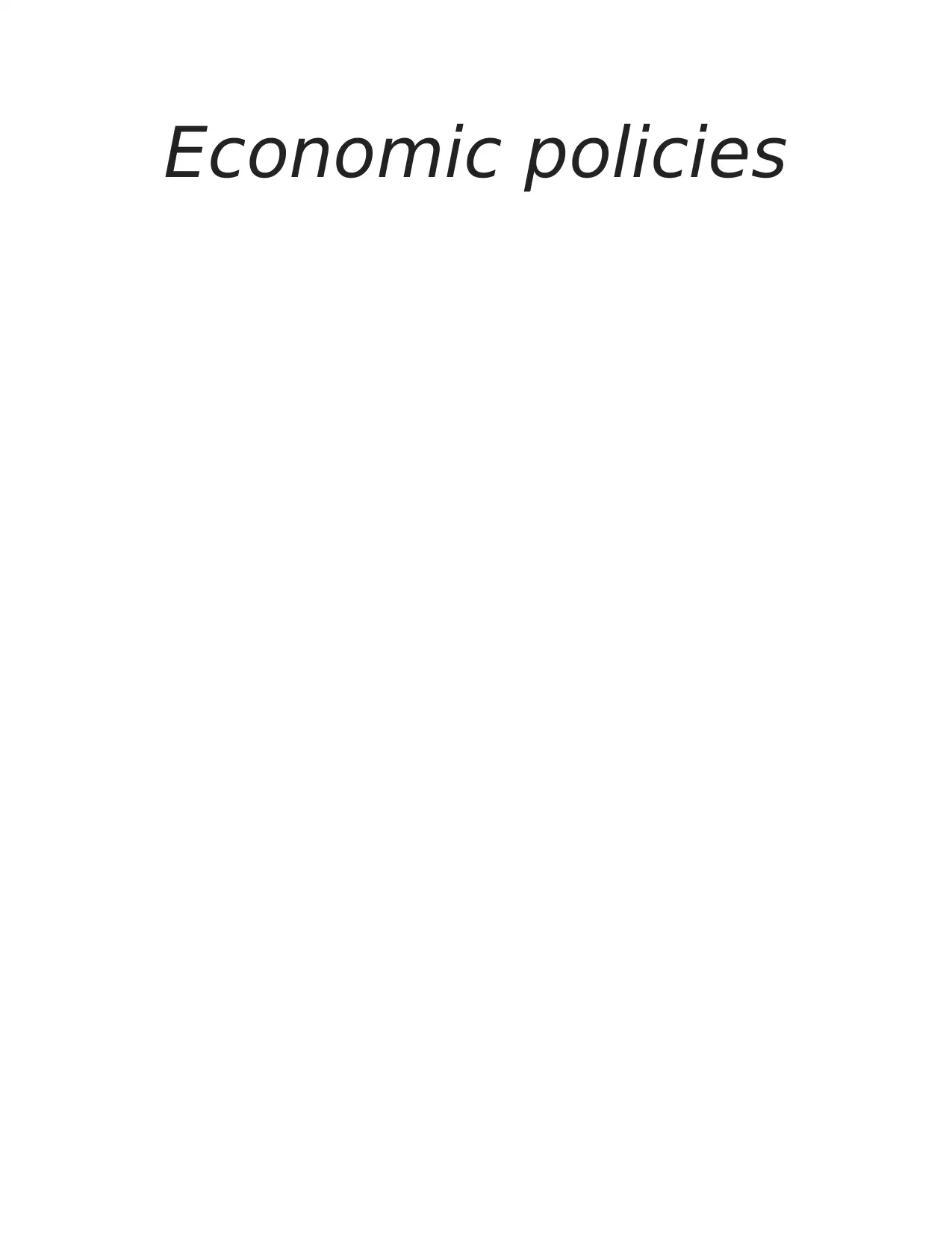
Economic policies
Paraphrase This Document
Need a fresh take? Get an instant paraphrase of this document with our AI Paraphraser
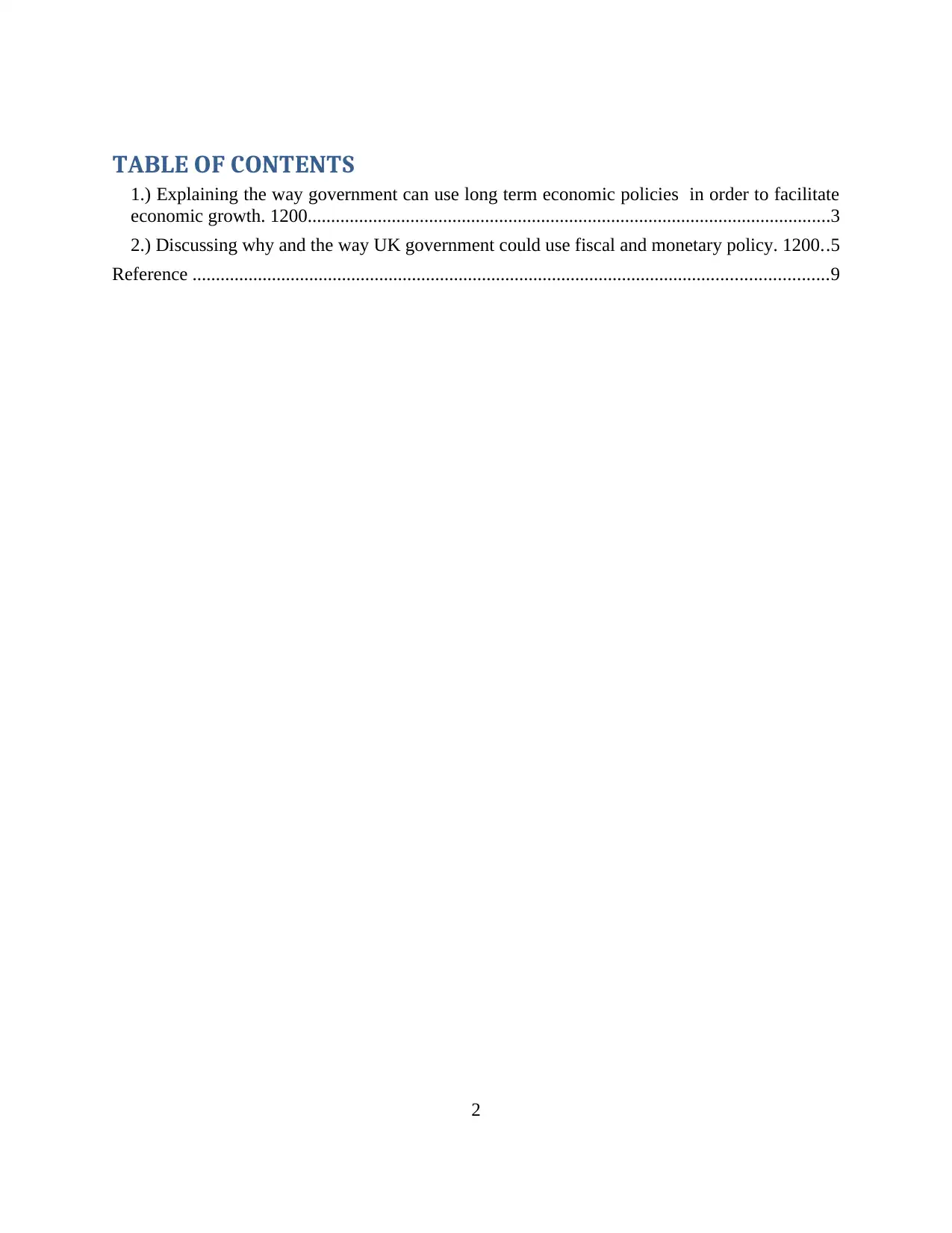
TABLE OF CONTENTS
1.) Explaining the way government can use long term economic policies in order to facilitate
economic growth. 1200................................................................................................................3
2.) Discussing why and the way UK government could use fiscal and monetary policy. 1200..5
Reference ........................................................................................................................................9
2
1.) Explaining the way government can use long term economic policies in order to facilitate
economic growth. 1200................................................................................................................3
2.) Discussing why and the way UK government could use fiscal and monetary policy. 1200..5
Reference ........................................................................................................................................9
2
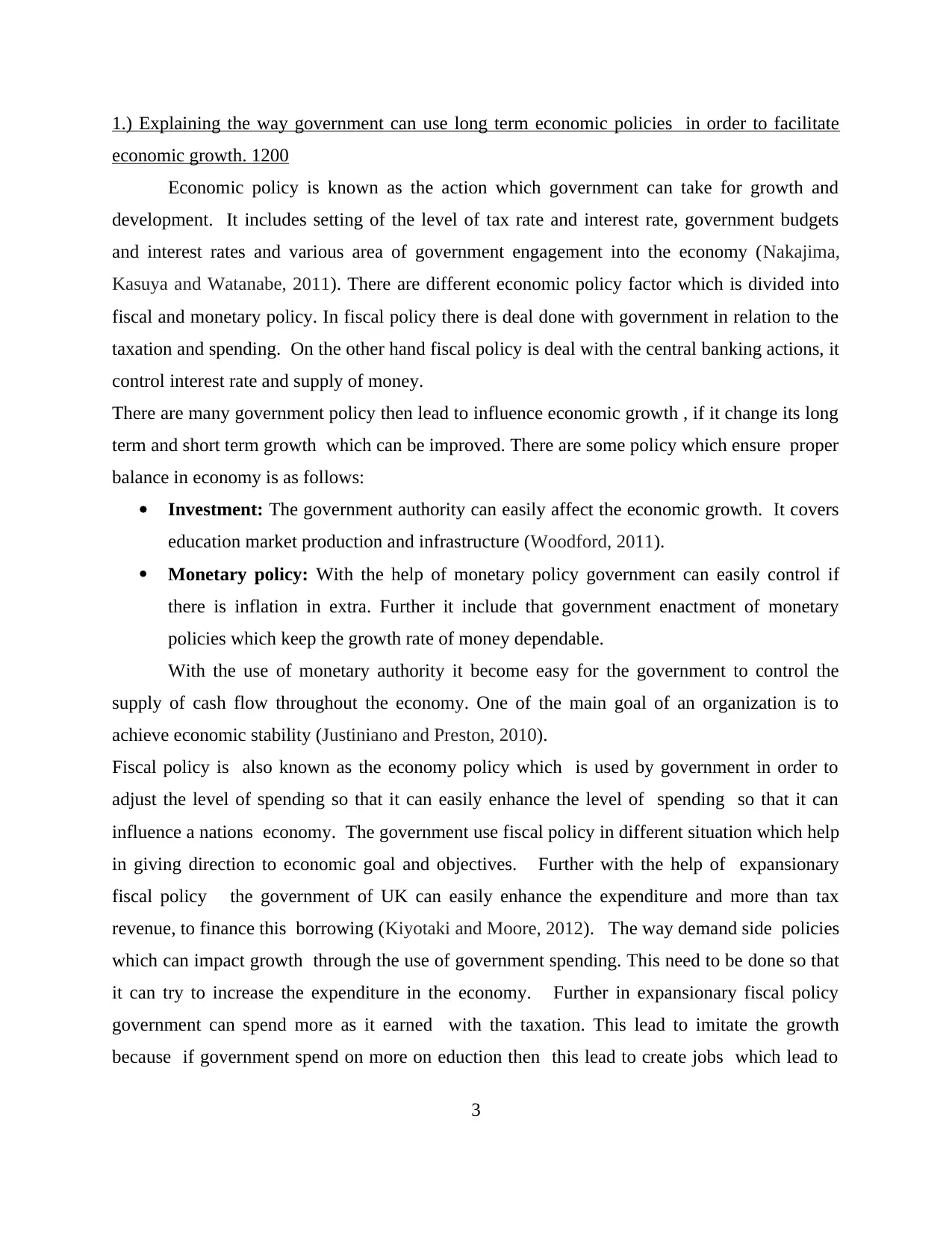
1.) Explaining the way government can use long term economic policies in order to facilitate
economic growth. 1200
Economic policy is known as the action which government can take for growth and
development. It includes setting of the level of tax rate and interest rate, government budgets
and interest rates and various area of government engagement into the economy (Nakajima,
Kasuya and Watanabe, 2011). There are different economic policy factor which is divided into
fiscal and monetary policy. In fiscal policy there is deal done with government in relation to the
taxation and spending. On the other hand fiscal policy is deal with the central banking actions, it
control interest rate and supply of money.
There are many government policy then lead to influence economic growth , if it change its long
term and short term growth which can be improved. There are some policy which ensure proper
balance in economy is as follows:
Investment: The government authority can easily affect the economic growth. It covers
education market production and infrastructure (Woodford, 2011).
Monetary policy: With the help of monetary policy government can easily control if
there is inflation in extra. Further it include that government enactment of monetary
policies which keep the growth rate of money dependable.
With the use of monetary authority it become easy for the government to control the
supply of cash flow throughout the economy. One of the main goal of an organization is to
achieve economic stability (Justiniano and Preston, 2010).
Fiscal policy is also known as the economy policy which is used by government in order to
adjust the level of spending so that it can easily enhance the level of spending so that it can
influence a nations economy. The government use fiscal policy in different situation which help
in giving direction to economic goal and objectives. Further with the help of expansionary
fiscal policy the government of UK can easily enhance the expenditure and more than tax
revenue, to finance this borrowing (Kiyotaki and Moore, 2012). The way demand side policies
which can impact growth through the use of government spending. This need to be done so that
it can try to increase the expenditure in the economy. Further in expansionary fiscal policy
government can spend more as it earned with the taxation. This lead to imitate the growth
because if government spend on more on eduction then this lead to create jobs which lead to
3
economic growth. 1200
Economic policy is known as the action which government can take for growth and
development. It includes setting of the level of tax rate and interest rate, government budgets
and interest rates and various area of government engagement into the economy (Nakajima,
Kasuya and Watanabe, 2011). There are different economic policy factor which is divided into
fiscal and monetary policy. In fiscal policy there is deal done with government in relation to the
taxation and spending. On the other hand fiscal policy is deal with the central banking actions, it
control interest rate and supply of money.
There are many government policy then lead to influence economic growth , if it change its long
term and short term growth which can be improved. There are some policy which ensure proper
balance in economy is as follows:
Investment: The government authority can easily affect the economic growth. It covers
education market production and infrastructure (Woodford, 2011).
Monetary policy: With the help of monetary policy government can easily control if
there is inflation in extra. Further it include that government enactment of monetary
policies which keep the growth rate of money dependable.
With the use of monetary authority it become easy for the government to control the
supply of cash flow throughout the economy. One of the main goal of an organization is to
achieve economic stability (Justiniano and Preston, 2010).
Fiscal policy is also known as the economy policy which is used by government in order to
adjust the level of spending so that it can easily enhance the level of spending so that it can
influence a nations economy. The government use fiscal policy in different situation which help
in giving direction to economic goal and objectives. Further with the help of expansionary
fiscal policy the government of UK can easily enhance the expenditure and more than tax
revenue, to finance this borrowing (Kiyotaki and Moore, 2012). The way demand side policies
which can impact growth through the use of government spending. This need to be done so that
it can try to increase the expenditure in the economy. Further in expansionary fiscal policy
government can spend more as it earned with the taxation. This lead to imitate the growth
because if government spend on more on eduction then this lead to create jobs which lead to
3
⊘ This is a preview!⊘
Do you want full access?
Subscribe today to unlock all pages.

Trusted by 1+ million students worldwide
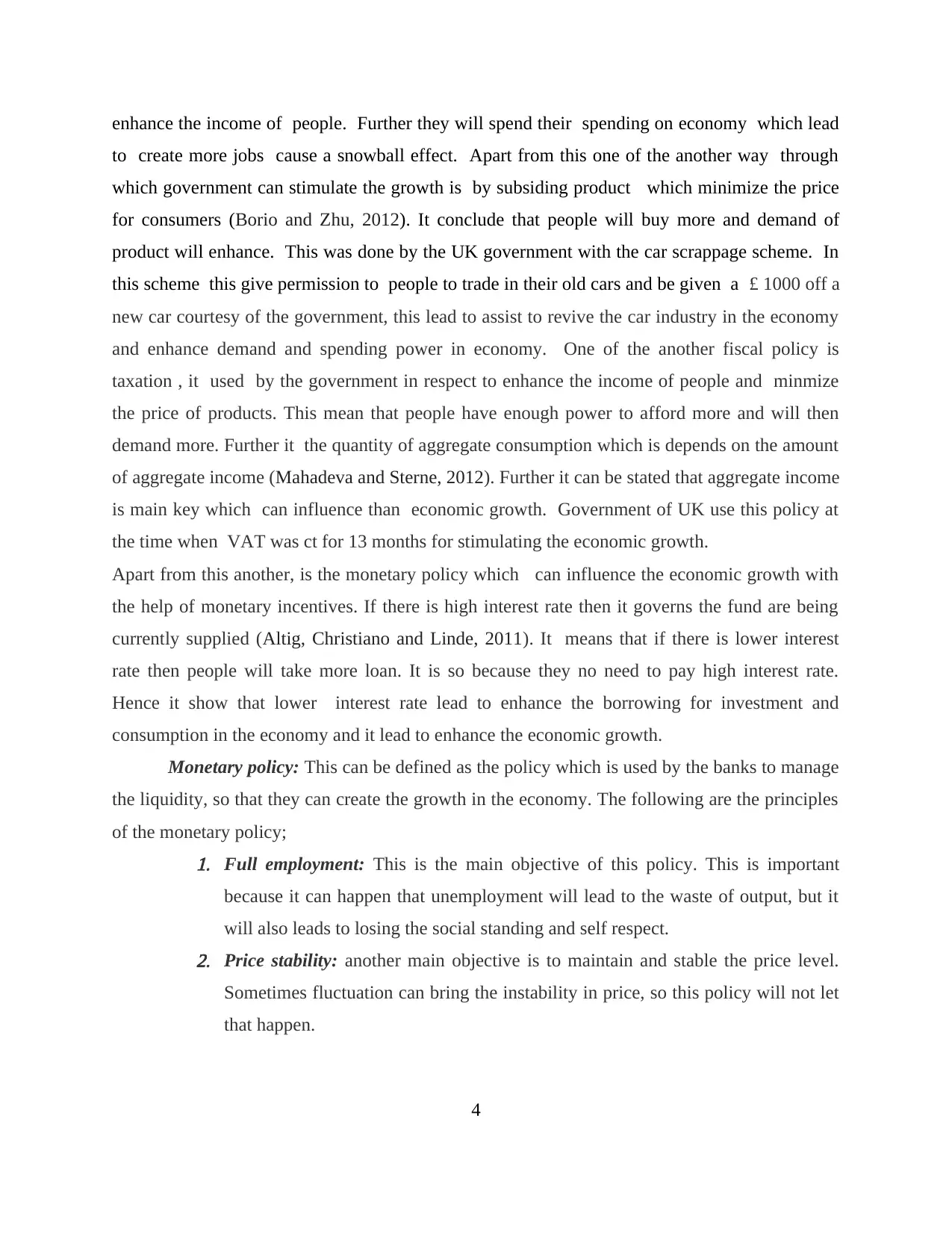
enhance the income of people. Further they will spend their spending on economy which lead
to create more jobs cause a snowball effect. Apart from this one of the another way through
which government can stimulate the growth is by subsiding product which minimize the price
for consumers (Borio and Zhu, 2012). It conclude that people will buy more and demand of
product will enhance. This was done by the UK government with the car scrappage scheme. In
this scheme this give permission to people to trade in their old cars and be given a £ 1000 off a
new car courtesy of the government, this lead to assist to revive the car industry in the economy
and enhance demand and spending power in economy. One of the another fiscal policy is
taxation , it used by the government in respect to enhance the income of people and minmize
the price of products. This mean that people have enough power to afford more and will then
demand more. Further it the quantity of aggregate consumption which is depends on the amount
of aggregate income (Mahadeva and Sterne, 2012). Further it can be stated that aggregate income
is main key which can influence than economic growth. Government of UK use this policy at
the time when VAT was ct for 13 months for stimulating the economic growth.
Apart from this another, is the monetary policy which can influence the economic growth with
the help of monetary incentives. If there is high interest rate then it governs the fund are being
currently supplied (Altig, Christiano and Linde, 2011). It means that if there is lower interest
rate then people will take more loan. It is so because they no need to pay high interest rate.
Hence it show that lower interest rate lead to enhance the borrowing for investment and
consumption in the economy and it lead to enhance the economic growth.
Monetary policy: This can be defined as the policy which is used by the banks to manage
the liquidity, so that they can create the growth in the economy. The following are the principles
of the monetary policy;
1. Full employment: This is the main objective of this policy. This is important
because it can happen that unemployment will lead to the waste of output, but it
will also leads to losing the social standing and self respect.
2. Price stability: another main objective is to maintain and stable the price level.
Sometimes fluctuation can bring the instability in price, so this policy will not let
that happen.
4
to create more jobs cause a snowball effect. Apart from this one of the another way through
which government can stimulate the growth is by subsiding product which minimize the price
for consumers (Borio and Zhu, 2012). It conclude that people will buy more and demand of
product will enhance. This was done by the UK government with the car scrappage scheme. In
this scheme this give permission to people to trade in their old cars and be given a £ 1000 off a
new car courtesy of the government, this lead to assist to revive the car industry in the economy
and enhance demand and spending power in economy. One of the another fiscal policy is
taxation , it used by the government in respect to enhance the income of people and minmize
the price of products. This mean that people have enough power to afford more and will then
demand more. Further it the quantity of aggregate consumption which is depends on the amount
of aggregate income (Mahadeva and Sterne, 2012). Further it can be stated that aggregate income
is main key which can influence than economic growth. Government of UK use this policy at
the time when VAT was ct for 13 months for stimulating the economic growth.
Apart from this another, is the monetary policy which can influence the economic growth with
the help of monetary incentives. If there is high interest rate then it governs the fund are being
currently supplied (Altig, Christiano and Linde, 2011). It means that if there is lower interest
rate then people will take more loan. It is so because they no need to pay high interest rate.
Hence it show that lower interest rate lead to enhance the borrowing for investment and
consumption in the economy and it lead to enhance the economic growth.
Monetary policy: This can be defined as the policy which is used by the banks to manage
the liquidity, so that they can create the growth in the economy. The following are the principles
of the monetary policy;
1. Full employment: This is the main objective of this policy. This is important
because it can happen that unemployment will lead to the waste of output, but it
will also leads to losing the social standing and self respect.
2. Price stability: another main objective is to maintain and stable the price level.
Sometimes fluctuation can bring the instability in price, so this policy will not let
that happen.
4
Paraphrase This Document
Need a fresh take? Get an instant paraphrase of this document with our AI Paraphraser
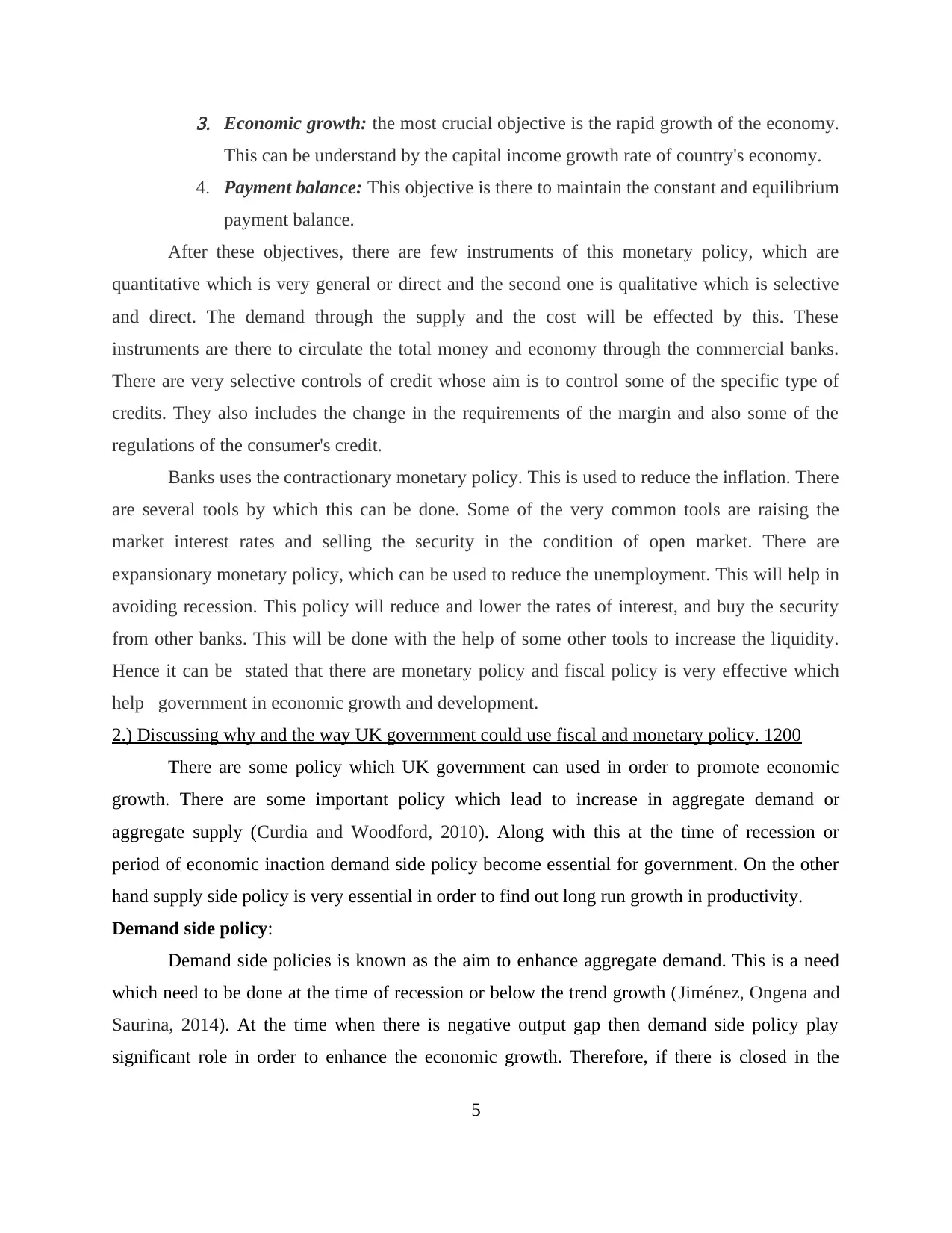
3. Economic growth: the most crucial objective is the rapid growth of the economy.
This can be understand by the capital income growth rate of country's economy.
4. Payment balance: This objective is there to maintain the constant and equilibrium
payment balance.
After these objectives, there are few instruments of this monetary policy, which are
quantitative which is very general or direct and the second one is qualitative which is selective
and direct. The demand through the supply and the cost will be effected by this. These
instruments are there to circulate the total money and economy through the commercial banks.
There are very selective controls of credit whose aim is to control some of the specific type of
credits. They also includes the change in the requirements of the margin and also some of the
regulations of the consumer's credit.
Banks uses the contractionary monetary policy. This is used to reduce the inflation. There
are several tools by which this can be done. Some of the very common tools are raising the
market interest rates and selling the security in the condition of open market. There are
expansionary monetary policy, which can be used to reduce the unemployment. This will help in
avoiding recession. This policy will reduce and lower the rates of interest, and buy the security
from other banks. This will be done with the help of some other tools to increase the liquidity.
Hence it can be stated that there are monetary policy and fiscal policy is very effective which
help government in economic growth and development.
2.) Discussing why and the way UK government could use fiscal and monetary policy. 1200
There are some policy which UK government can used in order to promote economic
growth. There are some important policy which lead to increase in aggregate demand or
aggregate supply (Curdia and Woodford, 2010). Along with this at the time of recession or
period of economic inaction demand side policy become essential for government. On the other
hand supply side policy is very essential in order to find out long run growth in productivity.
Demand side policy:
Demand side policies is known as the aim to enhance aggregate demand. This is a need
which need to be done at the time of recession or below the trend growth (Jiménez, Ongena and
Saurina, 2014). At the time when there is negative output gap then demand side policy play
significant role in order to enhance the economic growth. Therefore, if there is closed in the
5
This can be understand by the capital income growth rate of country's economy.
4. Payment balance: This objective is there to maintain the constant and equilibrium
payment balance.
After these objectives, there are few instruments of this monetary policy, which are
quantitative which is very general or direct and the second one is qualitative which is selective
and direct. The demand through the supply and the cost will be effected by this. These
instruments are there to circulate the total money and economy through the commercial banks.
There are very selective controls of credit whose aim is to control some of the specific type of
credits. They also includes the change in the requirements of the margin and also some of the
regulations of the consumer's credit.
Banks uses the contractionary monetary policy. This is used to reduce the inflation. There
are several tools by which this can be done. Some of the very common tools are raising the
market interest rates and selling the security in the condition of open market. There are
expansionary monetary policy, which can be used to reduce the unemployment. This will help in
avoiding recession. This policy will reduce and lower the rates of interest, and buy the security
from other banks. This will be done with the help of some other tools to increase the liquidity.
Hence it can be stated that there are monetary policy and fiscal policy is very effective which
help government in economic growth and development.
2.) Discussing why and the way UK government could use fiscal and monetary policy. 1200
There are some policy which UK government can used in order to promote economic
growth. There are some important policy which lead to increase in aggregate demand or
aggregate supply (Curdia and Woodford, 2010). Along with this at the time of recession or
period of economic inaction demand side policy become essential for government. On the other
hand supply side policy is very essential in order to find out long run growth in productivity.
Demand side policy:
Demand side policies is known as the aim to enhance aggregate demand. This is a need
which need to be done at the time of recession or below the trend growth (Jiménez, Ongena and
Saurina, 2014). At the time when there is negative output gap then demand side policy play
significant role in order to enhance the economic growth. Therefore, if there is closed in the
5
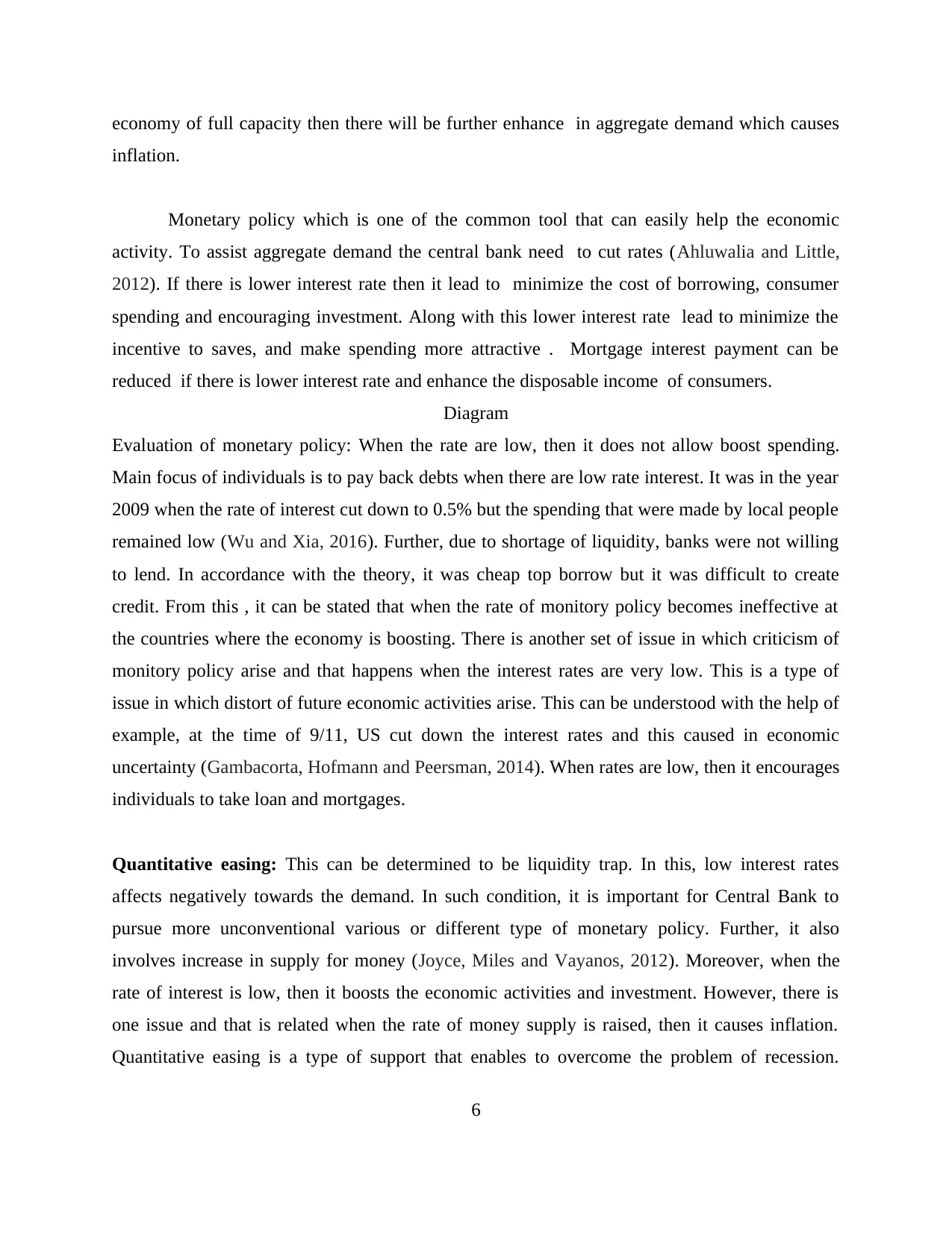
economy of full capacity then there will be further enhance in aggregate demand which causes
inflation.
Monetary policy which is one of the common tool that can easily help the economic
activity. To assist aggregate demand the central bank need to cut rates (Ahluwalia and Little,
2012). If there is lower interest rate then it lead to minimize the cost of borrowing, consumer
spending and encouraging investment. Along with this lower interest rate lead to minimize the
incentive to saves, and make spending more attractive . Mortgage interest payment can be
reduced if there is lower interest rate and enhance the disposable income of consumers.
Diagram
Evaluation of monetary policy: When the rate are low, then it does not allow boost spending.
Main focus of individuals is to pay back debts when there are low rate interest. It was in the year
2009 when the rate of interest cut down to 0.5% but the spending that were made by local people
remained low (Wu and Xia, 2016). Further, due to shortage of liquidity, banks were not willing
to lend. In accordance with the theory, it was cheap top borrow but it was difficult to create
credit. From this , it can be stated that when the rate of monitory policy becomes ineffective at
the countries where the economy is boosting. There is another set of issue in which criticism of
monitory policy arise and that happens when the interest rates are very low. This is a type of
issue in which distort of future economic activities arise. This can be understood with the help of
example, at the time of 9/11, US cut down the interest rates and this caused in economic
uncertainty (Gambacorta, Hofmann and Peersman, 2014). When rates are low, then it encourages
individuals to take loan and mortgages.
Quantitative easing: This can be determined to be liquidity trap. In this, low interest rates
affects negatively towards the demand. In such condition, it is important for Central Bank to
pursue more unconventional various or different type of monetary policy. Further, it also
involves increase in supply for money (Joyce, Miles and Vayanos, 2012). Moreover, when the
rate of interest is low, then it boosts the economic activities and investment. However, there is
one issue and that is related when the rate of money supply is raised, then it causes inflation.
Quantitative easing is a type of support that enables to overcome the problem of recession.
6
inflation.
Monetary policy which is one of the common tool that can easily help the economic
activity. To assist aggregate demand the central bank need to cut rates (Ahluwalia and Little,
2012). If there is lower interest rate then it lead to minimize the cost of borrowing, consumer
spending and encouraging investment. Along with this lower interest rate lead to minimize the
incentive to saves, and make spending more attractive . Mortgage interest payment can be
reduced if there is lower interest rate and enhance the disposable income of consumers.
Diagram
Evaluation of monetary policy: When the rate are low, then it does not allow boost spending.
Main focus of individuals is to pay back debts when there are low rate interest. It was in the year
2009 when the rate of interest cut down to 0.5% but the spending that were made by local people
remained low (Wu and Xia, 2016). Further, due to shortage of liquidity, banks were not willing
to lend. In accordance with the theory, it was cheap top borrow but it was difficult to create
credit. From this , it can be stated that when the rate of monitory policy becomes ineffective at
the countries where the economy is boosting. There is another set of issue in which criticism of
monitory policy arise and that happens when the interest rates are very low. This is a type of
issue in which distort of future economic activities arise. This can be understood with the help of
example, at the time of 9/11, US cut down the interest rates and this caused in economic
uncertainty (Gambacorta, Hofmann and Peersman, 2014). When rates are low, then it encourages
individuals to take loan and mortgages.
Quantitative easing: This can be determined to be liquidity trap. In this, low interest rates
affects negatively towards the demand. In such condition, it is important for Central Bank to
pursue more unconventional various or different type of monetary policy. Further, it also
involves increase in supply for money (Joyce, Miles and Vayanos, 2012). Moreover, when the
rate of interest is low, then it boosts the economic activities and investment. However, there is
one issue and that is related when the rate of money supply is raised, then it causes inflation.
Quantitative easing is a type of support that enables to overcome the problem of recession.
6
⊘ This is a preview!⊘
Do you want full access?
Subscribe today to unlock all pages.

Trusted by 1+ million students worldwide
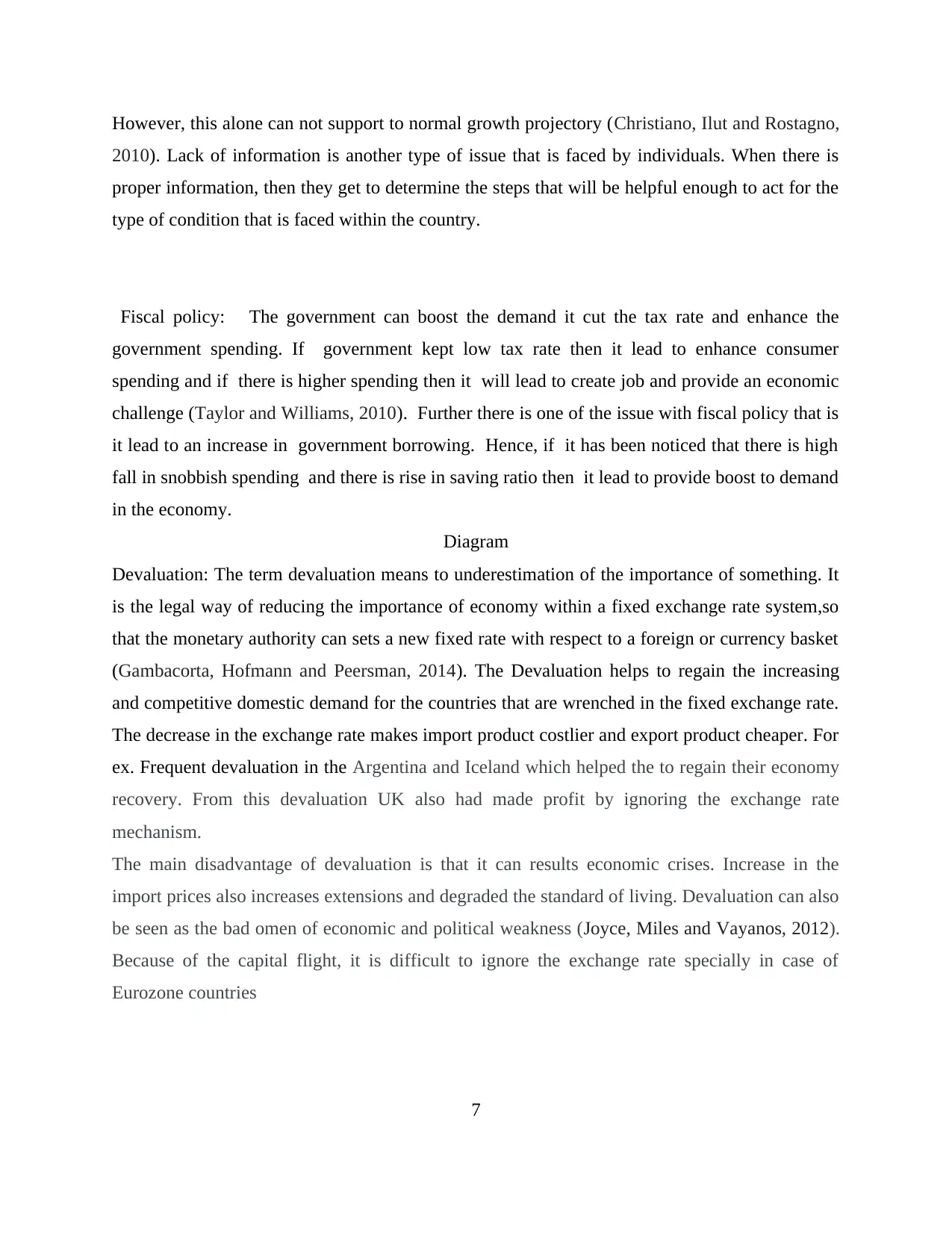
However, this alone can not support to normal growth projectory (Christiano, Ilut and Rostagno,
2010). Lack of information is another type of issue that is faced by individuals. When there is
proper information, then they get to determine the steps that will be helpful enough to act for the
type of condition that is faced within the country.
Fiscal policy: The government can boost the demand it cut the tax rate and enhance the
government spending. If government kept low tax rate then it lead to enhance consumer
spending and if there is higher spending then it will lead to create job and provide an economic
challenge (Taylor and Williams, 2010). Further there is one of the issue with fiscal policy that is
it lead to an increase in government borrowing. Hence, if it has been noticed that there is high
fall in snobbish spending and there is rise in saving ratio then it lead to provide boost to demand
in the economy.
Diagram
Devaluation: The term devaluation means to underestimation of the importance of something. It
is the legal way of reducing the importance of economy within a fixed exchange rate system,so
that the monetary authority can sets a new fixed rate with respect to a foreign or currency basket
(Gambacorta, Hofmann and Peersman, 2014). The Devaluation helps to regain the increasing
and competitive domestic demand for the countries that are wrenched in the fixed exchange rate.
The decrease in the exchange rate makes import product costlier and export product cheaper. For
ex. Frequent devaluation in the Argentina and Iceland which helped the to regain their economy
recovery. From this devaluation UK also had made profit by ignoring the exchange rate
mechanism.
The main disadvantage of devaluation is that it can results economic crises. Increase in the
import prices also increases extensions and degraded the standard of living. Devaluation can also
be seen as the bad omen of economic and political weakness (Joyce, Miles and Vayanos, 2012).
Because of the capital flight, it is difficult to ignore the exchange rate specially in case of
Eurozone countries
7
2010). Lack of information is another type of issue that is faced by individuals. When there is
proper information, then they get to determine the steps that will be helpful enough to act for the
type of condition that is faced within the country.
Fiscal policy: The government can boost the demand it cut the tax rate and enhance the
government spending. If government kept low tax rate then it lead to enhance consumer
spending and if there is higher spending then it will lead to create job and provide an economic
challenge (Taylor and Williams, 2010). Further there is one of the issue with fiscal policy that is
it lead to an increase in government borrowing. Hence, if it has been noticed that there is high
fall in snobbish spending and there is rise in saving ratio then it lead to provide boost to demand
in the economy.
Diagram
Devaluation: The term devaluation means to underestimation of the importance of something. It
is the legal way of reducing the importance of economy within a fixed exchange rate system,so
that the monetary authority can sets a new fixed rate with respect to a foreign or currency basket
(Gambacorta, Hofmann and Peersman, 2014). The Devaluation helps to regain the increasing
and competitive domestic demand for the countries that are wrenched in the fixed exchange rate.
The decrease in the exchange rate makes import product costlier and export product cheaper. For
ex. Frequent devaluation in the Argentina and Iceland which helped the to regain their economy
recovery. From this devaluation UK also had made profit by ignoring the exchange rate
mechanism.
The main disadvantage of devaluation is that it can results economic crises. Increase in the
import prices also increases extensions and degraded the standard of living. Devaluation can also
be seen as the bad omen of economic and political weakness (Joyce, Miles and Vayanos, 2012).
Because of the capital flight, it is difficult to ignore the exchange rate specially in case of
Eurozone countries
7
Paraphrase This Document
Need a fresh take? Get an instant paraphrase of this document with our AI Paraphraser
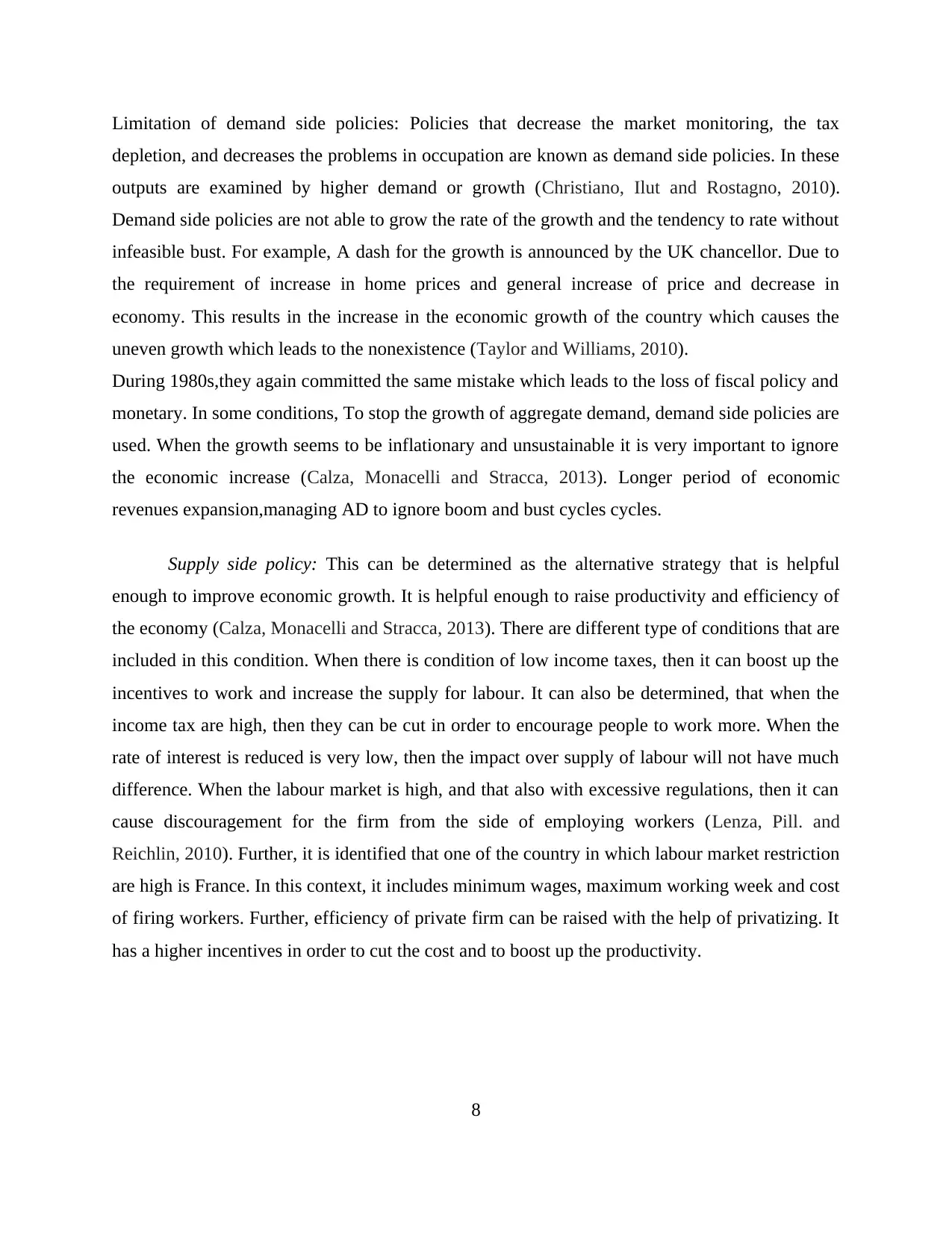
Limitation of demand side policies: Policies that decrease the market monitoring, the tax
depletion, and decreases the problems in occupation are known as demand side policies. In these
outputs are examined by higher demand or growth (Christiano, Ilut and Rostagno, 2010).
Demand side policies are not able to grow the rate of the growth and the tendency to rate without
infeasible bust. For example, A dash for the growth is announced by the UK chancellor. Due to
the requirement of increase in home prices and general increase of price and decrease in
economy. This results in the increase in the economic growth of the country which causes the
uneven growth which leads to the nonexistence (Taylor and Williams, 2010).
During 1980s,they again committed the same mistake which leads to the loss of fiscal policy and
monetary. In some conditions, To stop the growth of aggregate demand, demand side policies are
used. When the growth seems to be inflationary and unsustainable it is very important to ignore
the economic increase (Calza, Monacelli and Stracca, 2013). Longer period of economic
revenues expansion,managing AD to ignore boom and bust cycles cycles.
Supply side policy: This can be determined as the alternative strategy that is helpful
enough to improve economic growth. It is helpful enough to raise productivity and efficiency of
the economy (Calza, Monacelli and Stracca, 2013). There are different type of conditions that are
included in this condition. When there is condition of low income taxes, then it can boost up the
incentives to work and increase the supply for labour. It can also be determined, that when the
income tax are high, then they can be cut in order to encourage people to work more. When the
rate of interest is reduced is very low, then the impact over supply of labour will not have much
difference. When the labour market is high, and that also with excessive regulations, then it can
cause discouragement for the firm from the side of employing workers (Lenza, Pill. and
Reichlin, 2010). Further, it is identified that one of the country in which labour market restriction
are high is France. In this context, it includes minimum wages, maximum working week and cost
of firing workers. Further, efficiency of private firm can be raised with the help of privatizing. It
has a higher incentives in order to cut the cost and to boost up the productivity.
8
depletion, and decreases the problems in occupation are known as demand side policies. In these
outputs are examined by higher demand or growth (Christiano, Ilut and Rostagno, 2010).
Demand side policies are not able to grow the rate of the growth and the tendency to rate without
infeasible bust. For example, A dash for the growth is announced by the UK chancellor. Due to
the requirement of increase in home prices and general increase of price and decrease in
economy. This results in the increase in the economic growth of the country which causes the
uneven growth which leads to the nonexistence (Taylor and Williams, 2010).
During 1980s,they again committed the same mistake which leads to the loss of fiscal policy and
monetary. In some conditions, To stop the growth of aggregate demand, demand side policies are
used. When the growth seems to be inflationary and unsustainable it is very important to ignore
the economic increase (Calza, Monacelli and Stracca, 2013). Longer period of economic
revenues expansion,managing AD to ignore boom and bust cycles cycles.
Supply side policy: This can be determined as the alternative strategy that is helpful
enough to improve economic growth. It is helpful enough to raise productivity and efficiency of
the economy (Calza, Monacelli and Stracca, 2013). There are different type of conditions that are
included in this condition. When there is condition of low income taxes, then it can boost up the
incentives to work and increase the supply for labour. It can also be determined, that when the
income tax are high, then they can be cut in order to encourage people to work more. When the
rate of interest is reduced is very low, then the impact over supply of labour will not have much
difference. When the labour market is high, and that also with excessive regulations, then it can
cause discouragement for the firm from the side of employing workers (Lenza, Pill. and
Reichlin, 2010). Further, it is identified that one of the country in which labour market restriction
are high is France. In this context, it includes minimum wages, maximum working week and cost
of firing workers. Further, efficiency of private firm can be raised with the help of privatizing. It
has a higher incentives in order to cut the cost and to boost up the productivity.
8
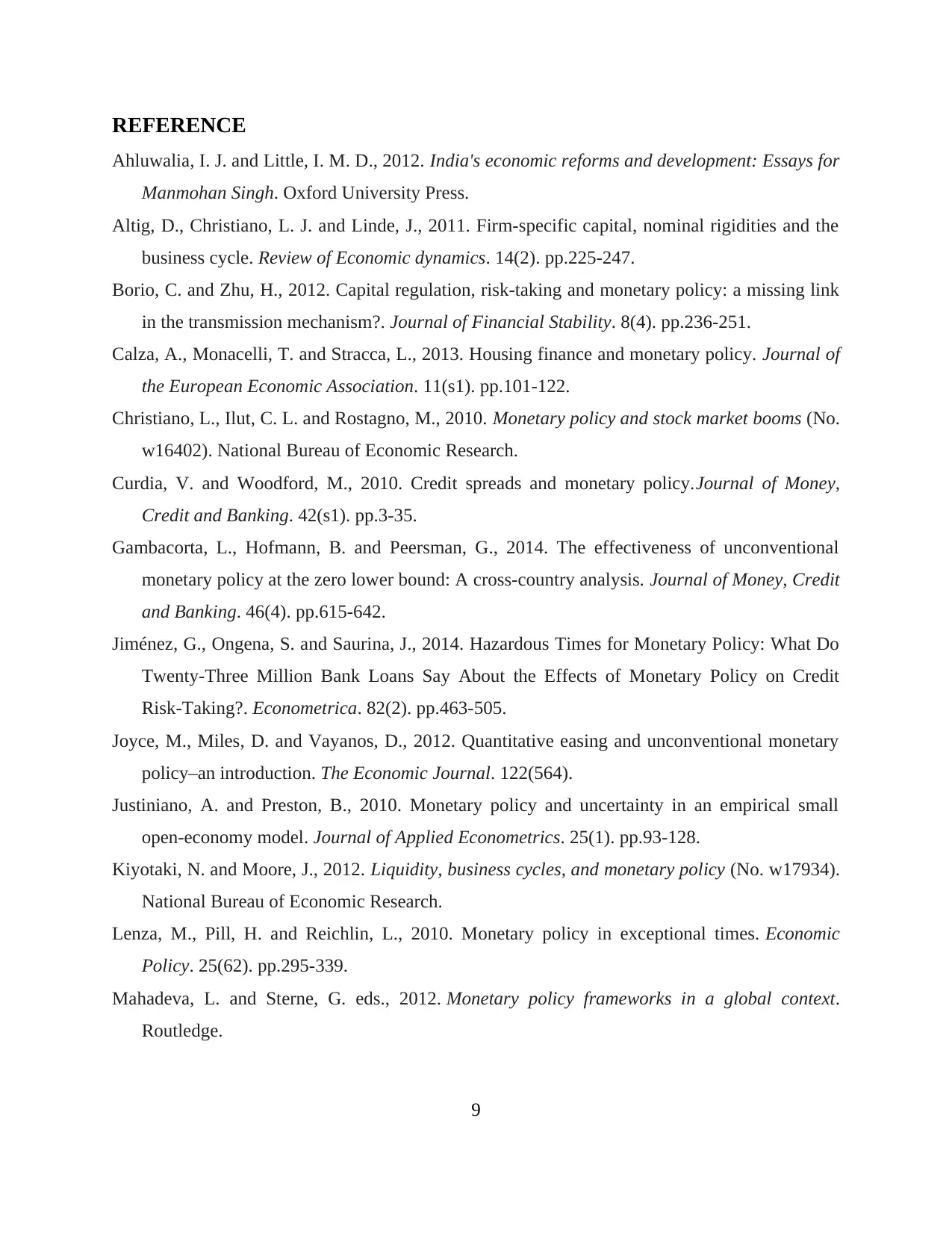
REFERENCE
Ahluwalia, I. J. and Little, I. M. D., 2012. India's economic reforms and development: Essays for
Manmohan Singh. Oxford University Press.
Altig, D., Christiano, L. J. and Linde, J., 2011. Firm-specific capital, nominal rigidities and the
business cycle. Review of Economic dynamics. 14(2). pp.225-247.
Borio, C. and Zhu, H., 2012. Capital regulation, risk-taking and monetary policy: a missing link
in the transmission mechanism?. Journal of Financial Stability. 8(4). pp.236-251.
Calza, A., Monacelli, T. and Stracca, L., 2013. Housing finance and monetary policy. Journal of
the European Economic Association. 11(s1). pp.101-122.
Christiano, L., Ilut, C. L. and Rostagno, M., 2010. Monetary policy and stock market booms (No.
w16402). National Bureau of Economic Research.
Curdia, V. and Woodford, M., 2010. Credit spreads and monetary policy.Journal of Money,
Credit and Banking. 42(s1). pp.3-35.
Gambacorta, L., Hofmann, B. and Peersman, G., 2014. The effectiveness of unconventional
monetary policy at the zero lower bound: A cross‐country analysis. Journal of Money, Credit
and Banking. 46(4). pp.615-642.
Jiménez, G., Ongena, S. and Saurina, J., 2014. Hazardous Times for Monetary Policy: What Do
Twenty‐Three Million Bank Loans Say About the Effects of Monetary Policy on Credit
Risk‐Taking?. Econometrica. 82(2). pp.463-505.
Joyce, M., Miles, D. and Vayanos, D., 2012. Quantitative easing and unconventional monetary
policy–an introduction. The Economic Journal. 122(564).
Justiniano, A. and Preston, B., 2010. Monetary policy and uncertainty in an empirical small
open‐economy model. Journal of Applied Econometrics. 25(1). pp.93-128.
Kiyotaki, N. and Moore, J., 2012. Liquidity, business cycles, and monetary policy (No. w17934).
National Bureau of Economic Research.
Lenza, M., Pill, H. and Reichlin, L., 2010. Monetary policy in exceptional times. Economic
Policy. 25(62). pp.295-339.
Mahadeva, L. and Sterne, G. eds., 2012. Monetary policy frameworks in a global context.
Routledge.
9
Ahluwalia, I. J. and Little, I. M. D., 2012. India's economic reforms and development: Essays for
Manmohan Singh. Oxford University Press.
Altig, D., Christiano, L. J. and Linde, J., 2011. Firm-specific capital, nominal rigidities and the
business cycle. Review of Economic dynamics. 14(2). pp.225-247.
Borio, C. and Zhu, H., 2012. Capital regulation, risk-taking and monetary policy: a missing link
in the transmission mechanism?. Journal of Financial Stability. 8(4). pp.236-251.
Calza, A., Monacelli, T. and Stracca, L., 2013. Housing finance and monetary policy. Journal of
the European Economic Association. 11(s1). pp.101-122.
Christiano, L., Ilut, C. L. and Rostagno, M., 2010. Monetary policy and stock market booms (No.
w16402). National Bureau of Economic Research.
Curdia, V. and Woodford, M., 2010. Credit spreads and monetary policy.Journal of Money,
Credit and Banking. 42(s1). pp.3-35.
Gambacorta, L., Hofmann, B. and Peersman, G., 2014. The effectiveness of unconventional
monetary policy at the zero lower bound: A cross‐country analysis. Journal of Money, Credit
and Banking. 46(4). pp.615-642.
Jiménez, G., Ongena, S. and Saurina, J., 2014. Hazardous Times for Monetary Policy: What Do
Twenty‐Three Million Bank Loans Say About the Effects of Monetary Policy on Credit
Risk‐Taking?. Econometrica. 82(2). pp.463-505.
Joyce, M., Miles, D. and Vayanos, D., 2012. Quantitative easing and unconventional monetary
policy–an introduction. The Economic Journal. 122(564).
Justiniano, A. and Preston, B., 2010. Monetary policy and uncertainty in an empirical small
open‐economy model. Journal of Applied Econometrics. 25(1). pp.93-128.
Kiyotaki, N. and Moore, J., 2012. Liquidity, business cycles, and monetary policy (No. w17934).
National Bureau of Economic Research.
Lenza, M., Pill, H. and Reichlin, L., 2010. Monetary policy in exceptional times. Economic
Policy. 25(62). pp.295-339.
Mahadeva, L. and Sterne, G. eds., 2012. Monetary policy frameworks in a global context.
Routledge.
9
⊘ This is a preview!⊘
Do you want full access?
Subscribe today to unlock all pages.

Trusted by 1+ million students worldwide
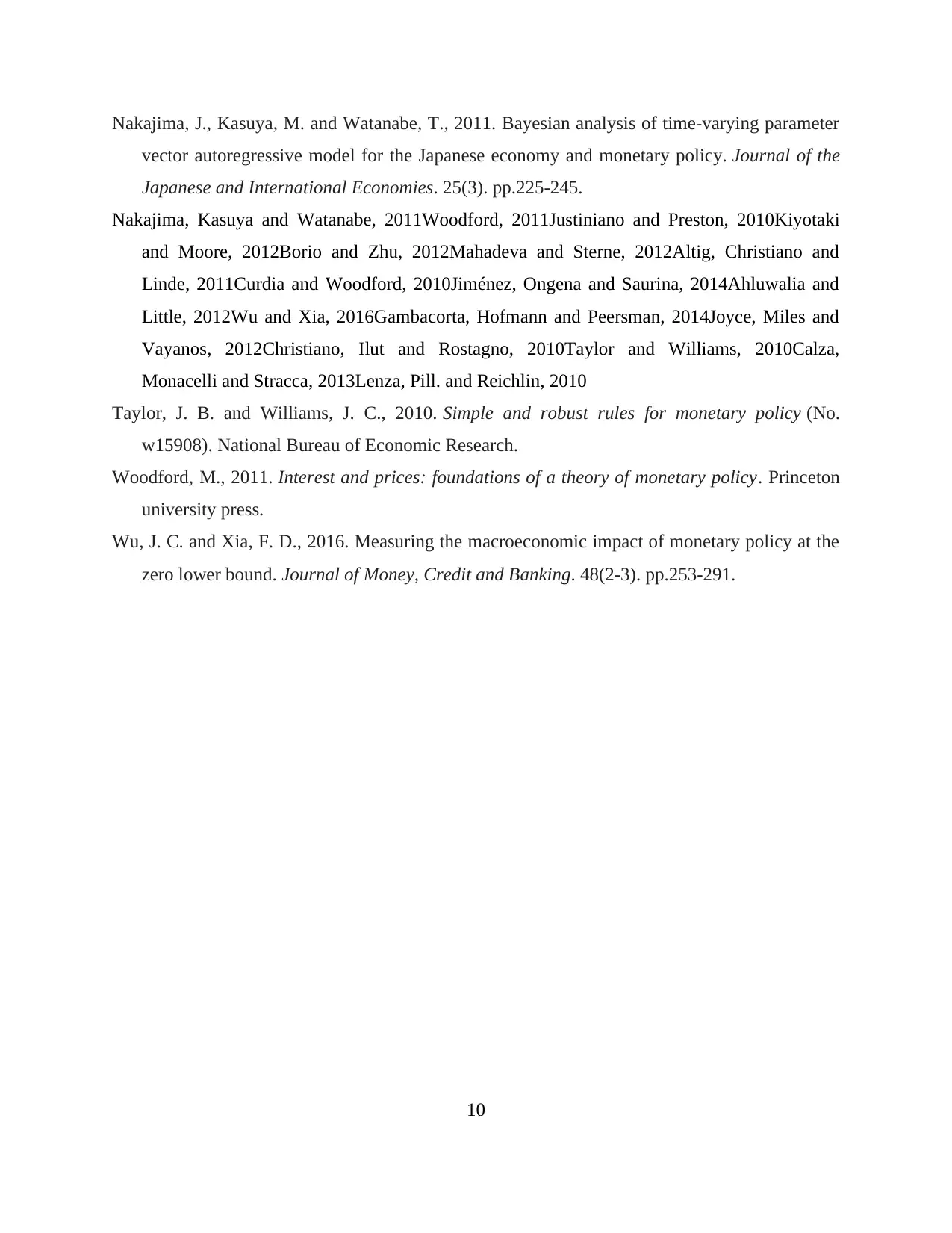
Nakajima, J., Kasuya, M. and Watanabe, T., 2011. Bayesian analysis of time-varying parameter
vector autoregressive model for the Japanese economy and monetary policy. Journal of the
Japanese and International Economies. 25(3). pp.225-245.
Nakajima, Kasuya and Watanabe, 2011Woodford, 2011Justiniano and Preston, 2010Kiyotaki
and Moore, 2012Borio and Zhu, 2012Mahadeva and Sterne, 2012Altig, Christiano and
Linde, 2011Curdia and Woodford, 2010Jiménez, Ongena and Saurina, 2014Ahluwalia and
Little, 2012Wu and Xia, 2016Gambacorta, Hofmann and Peersman, 2014Joyce, Miles and
Vayanos, 2012Christiano, Ilut and Rostagno, 2010Taylor and Williams, 2010Calza,
Monacelli and Stracca, 2013Lenza, Pill. and Reichlin, 2010
Taylor, J. B. and Williams, J. C., 2010. Simple and robust rules for monetary policy (No.
w15908). National Bureau of Economic Research.
Woodford, M., 2011. Interest and prices: foundations of a theory of monetary policy. Princeton
university press.
Wu, J. C. and Xia, F. D., 2016. Measuring the macroeconomic impact of monetary policy at the
zero lower bound. Journal of Money, Credit and Banking. 48(2-3). pp.253-291.
10
vector autoregressive model for the Japanese economy and monetary policy. Journal of the
Japanese and International Economies. 25(3). pp.225-245.
Nakajima, Kasuya and Watanabe, 2011Woodford, 2011Justiniano and Preston, 2010Kiyotaki
and Moore, 2012Borio and Zhu, 2012Mahadeva and Sterne, 2012Altig, Christiano and
Linde, 2011Curdia and Woodford, 2010Jiménez, Ongena and Saurina, 2014Ahluwalia and
Little, 2012Wu and Xia, 2016Gambacorta, Hofmann and Peersman, 2014Joyce, Miles and
Vayanos, 2012Christiano, Ilut and Rostagno, 2010Taylor and Williams, 2010Calza,
Monacelli and Stracca, 2013Lenza, Pill. and Reichlin, 2010
Taylor, J. B. and Williams, J. C., 2010. Simple and robust rules for monetary policy (No.
w15908). National Bureau of Economic Research.
Woodford, M., 2011. Interest and prices: foundations of a theory of monetary policy. Princeton
university press.
Wu, J. C. and Xia, F. D., 2016. Measuring the macroeconomic impact of monetary policy at the
zero lower bound. Journal of Money, Credit and Banking. 48(2-3). pp.253-291.
10
1 out of 10
Related Documents
Your All-in-One AI-Powered Toolkit for Academic Success.
+13062052269
info@desklib.com
Available 24*7 on WhatsApp / Email
![[object Object]](/_next/static/media/star-bottom.7253800d.svg)
Unlock your academic potential
Copyright © 2020–2025 A2Z Services. All Rights Reserved. Developed and managed by ZUCOL.





